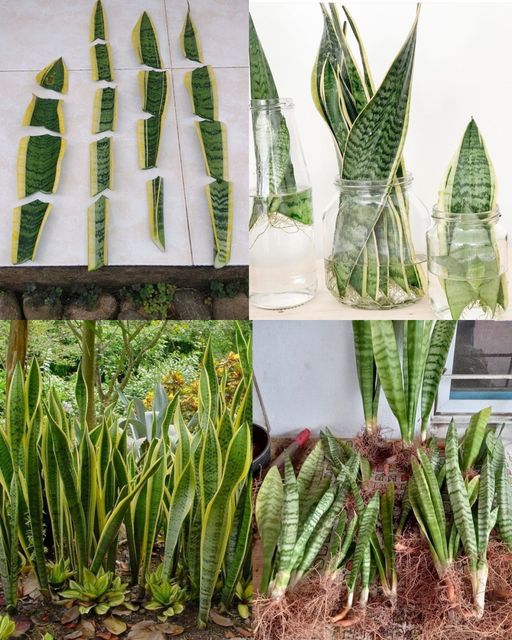Transform One Sansevieria into Many: Your Quick Guide to Multiplying Success:
Sansevieria, also known as the snake plant or mother-in-law’s tongue, is a popular, hardy houseplant appreciated for its unique, sword-like leaves and easy care. If you’re looking to expand your collection or share your love of Sansevieria with friends, propagating the plant is an excellent way to multiply your success. Fortunately, propagating Sansevieria is simple and can be done using two main methods: leaf cuttings and division. In this quick guide, we’ll walk you through the process of turning one healthy Sansevieria into many new plants. Let’s dive in!
1. Tools Needed:
Before you begin, gather the necessary tools to make the propagation process smooth and successful:
- Sharp Knife or Scissors: These will help you make clean, precise cuts for the leaf cutting method.
- Pots: Small pots or containers to transplant the new plants into once they’ve rooted.
- Well-Draining Soil: Sansevieria plants prefer soil that drains well, so make sure you use a suitable potting mix (cactus or succulent mix works well).
2. Leaf Cuttings Method:
Propagating Sansevieria through leaf cuttings is one of the easiest methods to multiply your plant collection.
Steps for Leaf Cuttings:
- Select a Healthy Leaf: Choose a mature, healthy Sansevieria leaf. Look for a leaf that is free of damage and disease.
- Cut the Leaf: Using a sharp knife or scissors, cut the leaf into 3-4 inch sections. Each section will become a new plant, so be sure to cut them into manageable pieces.
- Let the Cuttings Dry: After cutting, lay the leaf sections out in a dry spot for a few days. This allows the cut edges to callous over, which helps prevent rotting once planted.
- Plant the Cuttings: Once the cut ends are calloused, plant the sections upright in a small pot with well-draining soil. Bury the cuttings deep enough so they stand up on their own. Make sure the cut end is facing down in the soil.
- Watering the Cuttings: Water the cuttings lightly, just enough to moisten the soil. Avoid overwatering, as the cuttings don’t need a lot of moisture while they’re rooting.
3. Division Method:
If you have a mature Sansevieria plant, you can propagate it by dividing the root ball. This method allows you to create multiple plants from a single existing Sansevieria.
Steps for Division:
- Remove the Plant from Its Pot: Gently remove the Sansevieria from its pot. Be careful not to damage the roots while handling the plant.
- Separate the Root Clumps: Examine the root system, which should have multiple clumps or sections that can be separated. Use your hands or a clean knife to carefully separate the roots into smaller sections, ensuring each division has its own roots and some leaves attached.
- Replant the Divided Sections: Place each new section into its own pot with fresh, well-draining soil. Make sure the roots are well covered, and the plant stands upright.
- Watering the Divisions: Water each newly potted section sparingly, as they don’t need too much water right away. Allow the roots to establish before increasing watering.
4. Watering and Care:
Proper care after propagation is essential for healthy growth.
- Water Sparingly: Sansevieria plants are drought-tolerant, so avoid overwatering. Water the new plants lightly, just enough to keep the soil moist until the roots are established. Once the roots are growing, you can gradually increase watering.
- Light: Place your new Sansevieria plants in a location with bright, indirect light. While Sansevierias are adaptable to low light conditions, they grow best with a bit of sunlight. Avoid direct sunlight, as this can scorch the leaves.
- Temperature: Sansevierias thrive in warm environments, ideally between 60-85°F (15-29°C). Keep the new plants in a place where they can maintain a consistent temperature.
5. Patience and Observation:
Propagation can take time, so patience is key to success.
- New Growth: After several weeks, you should begin to see new shoots emerging from the soil. This is a clear sign that your Sansevieria cuttings or divisions are rooting successfully.
- Root Development: You may not see roots immediately, but over time, the plants will develop a strong root system. You can check for root development by gently tugging on the plants. If there’s resistance, the roots are likely established.
Conclusion: Enjoy Your New Plants:
By following these simple steps, you can successfully propagate your Sansevieria and enjoy multiple new plants. Whether you choose the leaf cutting method or the division method, both are effective ways to expand your collection or share the beauty of this hardy, low-maintenance plant with others.
Remember to be patient, care for your new plants with the right amount of light and water, and soon you’ll have a thriving Sansevieria garden. Happy propagating!
